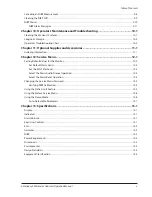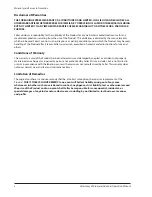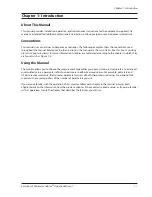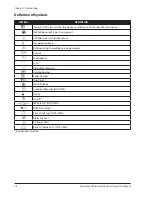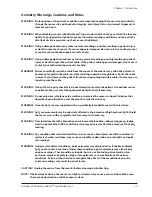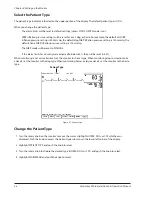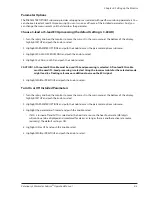
Chapter 1: Introduction
Veterinary 3 Parameter Advisor
®
Operation Manual
1-7
Oximetry Warnings, Cautions, and Notes
WARNING! Prolonged use or the patient’s condition may require changing the sensor site periodically.
Change the sensor site and check skin integrity, circulatory status, and correct alignment at
least every 4 hours.
WARNING! When attaching sensors with Microfoam
®
tape, do not stretch the tape or attach the tape too
tightly. Tape applied too tightly may cause inaccurate readings and blisters on the patient’s
skin (lack of skin respiration, not heat, causes the blisters).
WARNING! Using a damaged sensor may cause inaccurate readings, possibly resulting in patient injury
or death. Inspect each sensor. If a sensor appears damaged, do not use it. Use another sensor
or contact your authorized repair center for help.
WARNING! Using a damaged patient cable may cause inaccurate readings, possibly resulting in patient
injury or death. Inspect the patient cable. If the patient cable appears damaged, do not use it.
Contact your authorized repair center for help.
WARNING! Failure to carefully route the cable from the sensor to the monitor may allow the patient to
become entangled in the cable, possibly resulting in patient strangulation. Route the cable
in a way that will prevent the patient from becoming entangled in the cable. If necessary, use
tape to secure the cable.
WARNING! If any of the integrity checks fail, do not attempt to monitor the patient. Use another sensor
or patient cable, or contact the equipment dealer for help if necessary.
WARNING! Do not autoclave, ethylene oxide sterilize, or immerse the sensors in liquid. Evidence that
liquid has been allowed to enter the monitor voids the warranty.
WARNING! Use only SpO
2
sensors supplied with, or specifically intended for use with, this device.
WARNING! SpO
2
measurements may be adversely affected in the presence of high ambient light. Shield
the sensor area (with a surgical towel, for example) if necessary.
WARNING! Dyes introduced into the bloodstream, such as methylene blue, indocyanine green, indigo
carmine, patent blue V (PBV), and fluorescein may adversely affect the accuracy of the SpO
2
reading.
WARNING! Any condition that restricts blood flow, such as use of a blood pressure cuff or extremes in
systemic vascular resistance, may cause an inability to determine accurate SpO
2
and pulse
rate readings.
WARNING! Under certain clinical conditions, pulse oximeters may display dashes if unable to display
SpO
2
and/or pulse rate values. Under these conditions, pulse oximeters may also display
erroneous values. These conditions include, but are not limited to: patient motion, low
perfusion, cardiac arrhythmias, high or low pulse rates or a combination of the above
conditions. Failure of the clinician to recognize the effects of these conditions on pulse
oximeter readings may result in patient injury.
CAUTION! Unplug the sensor from the monitor before cleaning or disinfecting.
NOTE! Obstructions or dirt on the sensor’s red light or detector may cause a sensor failure. Make sure
there are no obstructions and the sensor is clean.

